The Canon EOS 350D, released in 2005, is an 8-megapixel DSLR featuring an APS-C sensor, compact design, and intuitive controls, making it ideal for photography enthusiasts and professionals.
1.1 Overview of the Camera
The Canon EOS 350D is an 8-megapixel DSLR camera designed for photography enthusiasts and professionals. It features a compact and lightweight body, making it easy to carry. The camera is equipped with a 22.2mm x 14.9mm APS-C CMOS sensor and the DIGIC II image processor, ensuring high-quality images with vibrant colors. It offers a 2.4-inch LCD screen for previewing shots and reviewing images. The EOS 350D supports EF and EF-S lenses, providing versatility for various photography needs. With its intuitive controls and advanced features, it is ideal for capturing portraits, landscapes, and action shots with precision and ease.
1.2 Importance of Reading the Manual
Reading the Canon EOS 350D manual is essential to fully understand the camera’s capabilities and features. It provides detailed explanations of settings, modes, and functions, helping users optimize their photography experience. The manual also includes troubleshooting tips and maintenance advice, ensuring longevity and performance. By familiarizing yourself with the guide, you can unlock advanced features, resolve common issues, and improve your overall shooting skills. It serves as a comprehensive resource for both beginners and experienced photographers, enabling them to make the most of their Canon EOS 350D and capture high-quality images with confidence and precision.

Unpacking and Accessories
Upon unboxing, the Canon EOS 350D includes essential accessories like the camera body, EF-S 18-55mm lens, battery, charger, and neck strap. Additional compatible lenses and flashes enhance functionality.
2.1 Items Included in the Box
When you unbox your Canon EOS 350D, you’ll find the camera body, an EF-S 18-55mm f/3.5-5.6 lens, a rechargeable lithium-ion battery (NB-2LH), a battery charger (CB-2LT), and a neck strap. Additionally, the package includes a USB cable for transferring images to your computer, a CD-ROM containing EOS Digital Solution Disk software, and a printed manual. Ensure all items are present to get started with your photography journey seamlessly. These accessories provide everything needed to begin capturing high-quality images right out of the box.
2.2 Compatible Lenses and Accessories
The Canon EOS 350D is compatible with EF-S and EF lenses, offering versatility for various photography needs. Popular options include the EF-S 17-85mm f/3.5-5.6 IS USM and EF 50mm f/1.8 II. Additional accessories like external Speedlite flashes, remote shutters, and tripods enhance functionality. The camera supports SD and SDHC memory cards for storage. Ensure all accessories are Canon-compatible to maintain performance and reliability. Exploring these options allows users to expand their creative possibilities while ensuring optimal compatibility with their EOS 350D.
Key Features of the Canon EOS 350D
The Canon EOS 350D features an 8.0-megapixel APS-C CMOS sensor, DIGIC II image processor, 2.4 fps burst mode, 2.5-inch LCD screen, and compatibility with SD memory cards.
3.1 Overview of Camera Specifications
The Canon EOS 350D boasts an 8.0-megapixel APS-C CMOS sensor, offering crisp and detailed images. It features the DIGIC II image processor for enhanced performance and color accuracy. The camera supports burst shooting at 2.4 frames per second, allowing photographers to capture fleeting moments. A 2.5-inch LCD screen provides clear image preview and settings adjustment. It uses SD memory cards for storage and supports EF-S lenses, ensuring compatibility with a wide range of optics. The lightweight and ergonomic design makes it portable and easy to handle for extended photography sessions.
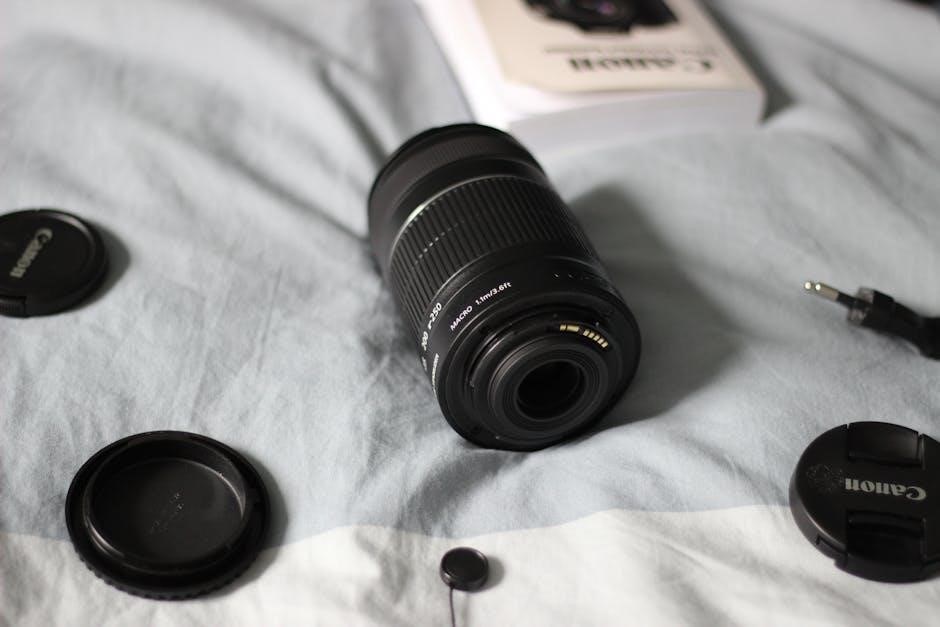
Getting Started
Begin by unpacking and charging the battery. Familiarize yourself with the camera’s layout and basic controls. Refer to the manual for initial setup and configuration guidance.
4.1 Basic Camera Controls and Layout
The Canon EOS 350D features an intuitive and ergonomic design. The mode dial on top allows quick access to shooting modes like Auto, Av, Tv, and Manual. The shutter button is centrally located for easy access. The multi-controller on the back enables navigation through menus and image playback. The LCD screen displays settings and previews images. Dedicated buttons for ISO, white balance, and drive mode simplify adjustments. The camera’s layout is designed for ease of use, with controls positioned for quick access during shooting. Familiarizing yourself with these elements will enhance your shooting experience and streamline your workflow.
4.2 Initial Setup and Configuration
Before using your Canon EOS 350D, ensure proper setup. Insert the battery and memory card, then power on the camera. Set the date, time, and language using the menu. Familiarize yourself with the mode dial, which offers options like Auto, P, Av, Tv, M, and custom modes (C1, C2, C3). Navigate settings using the multi-controller and quick control dial. Review shooting settings on the LCD screen. For optimal performance, refer to the manual to customize settings like autofocus, white balance, and ISO sensitivity. Proper initial configuration ensures a smooth and efficient shooting experience, tailored to your preferences and needs.
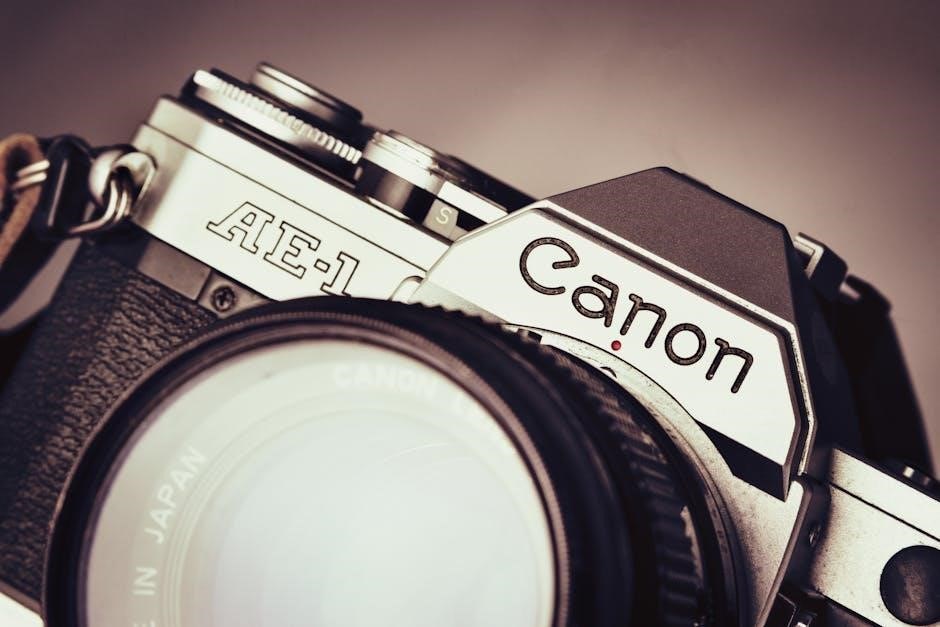
Shooting Modes
The Canon EOS 350D offers versatile shooting modes, including Auto, Creative Zone (Av, Tv, M), and Custom (C1, C2, C3), catering to both simplicity and advanced control.
5.1 Auto Mode for Beginners
The Canon EOS 350D’s Auto Mode is designed for beginners, offering a hassle-free experience by automatically adjusting settings like aperture, shutter speed, and ISO for optimal results. This mode simplifies photography, allowing users to focus on composition without manual adjustments. It’s perfect for capturing everyday moments, portraits, and landscapes with minimal effort. The camera’s advanced algorithms ensure balanced exposure, vibrant colors, and sharp focus, making it an excellent starting point for new photographers. By relying on Auto Mode, users can gradually learn the basics before exploring more advanced settings and creative modes.
5.2 Creative Zone Modes (Av, Tv, M)
The Canon EOS 350D’s Creative Zone Modes—Aperture Priority (Av), Shutter Priority (Tv), and Manual (M)—offer advanced control for photographers seeking customization. In Av mode, users set the aperture, while the camera adjusts shutter speed for optimal exposure, ideal for controlling depth of field. Tv mode allows setting shutter speed to freeze or blur motion, perfect for action or creative effects. Manual mode (M) provides full control over both aperture and shutter speed, enabling precise adjustments for unique artistic expression. These modes empower users to experiment with lighting, motion, and composition, unlocking the camera’s full creative potential.
5.3 Custom Modes (C1, C2, C3)
The Canon EOS 350D offers three Custom Modes (C1, C2, C3) that allow users to save personalized camera settings for quick access. These modes are ideal for photographers who frequently shoot in specific conditions or styles. For example, you can configure settings like aperture, shutter speed, ISO, and white balance for scenarios such as portraits, landscapes, or low-light photography. Once configured, these settings are stored and can be instantly recalled, streamlining your workflow. This feature enhances efficiency and ensures consistent results across different shooting environments, making it a valuable tool for both amateur and professional photographers. Custom Modes add flexibility and convenience to your photography process.
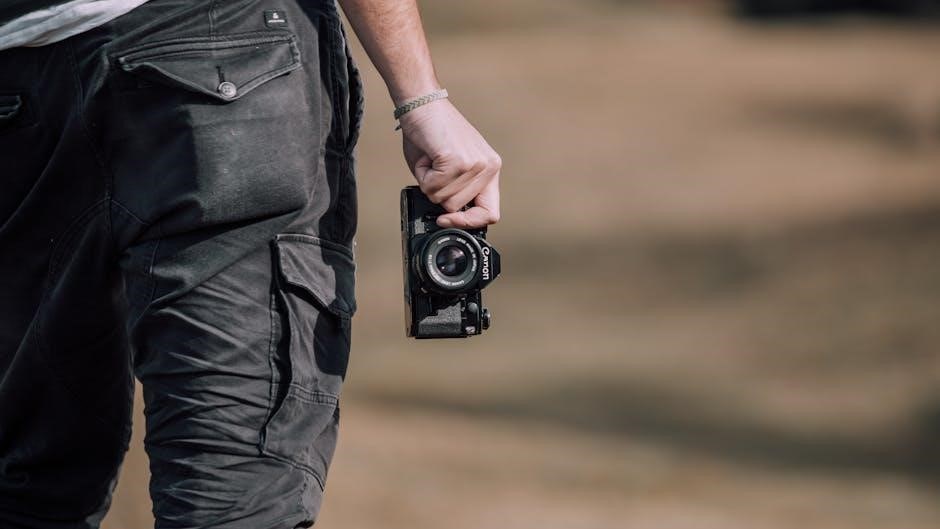
Customizing Your Camera
The Canon EOS 350D offers customization options, allowing users to adjust White Balance, ISO settings, and Autofocus modes to capture unique perspectives and enhance creativity.
6.1 White Balance Settings
The Canon EOS 350D allows users to customize White Balance settings, ensuring accurate color representation in various lighting conditions. Options include Auto, Daylight, Shade, Tungsten, Fluorescent, and Custom modes. By selecting the appropriate preset or setting a custom value, photographers can achieve natural hues and enhance image quality. This feature is particularly useful for capturing scenes with specific lighting, such as indoor events or outdoor shots under different skies, providing flexibility and control over the visual outcome of each photograph.
6.2 ISO Sensitivity and Noise Reduction
The Canon EOS 350D offers ISO sensitivity ranging from 100 to 1600, allowing photographers to shoot in various lighting conditions. Lower ISO settings (100-400) are ideal for bright environments, minimizing noise, while higher ISOs (800-1600) enable shooting in low light but may introduce grain. The camera also features built-in noise reduction, which helps maintain image clarity, especially in high ISO or long exposure shots. This feature ensures that photos remain sharp and detailed, even in challenging lighting scenarios, making the EOS 350D versatile for both casual and professional use.
6.3 Autofocus Modes (One-Shot, AI Focus, AI Servo)
The Canon EOS 350D features three autofocus modes tailored for different shooting scenarios. One-Shot AF is ideal for stationary subjects, locking focus once the shutter is pressed halfway. AI Focus AF automatically switches between One-Shot and AI Servo, detecting subject movement. AI Servo AF continuously adjusts focus for moving subjects, making it perfect for action or wildlife photography. These modes ensure precise focus control, allowing photographers to capture sharp images in various situations, from portraits to dynamic action shots, enhancing overall shooting flexibility and creativity.
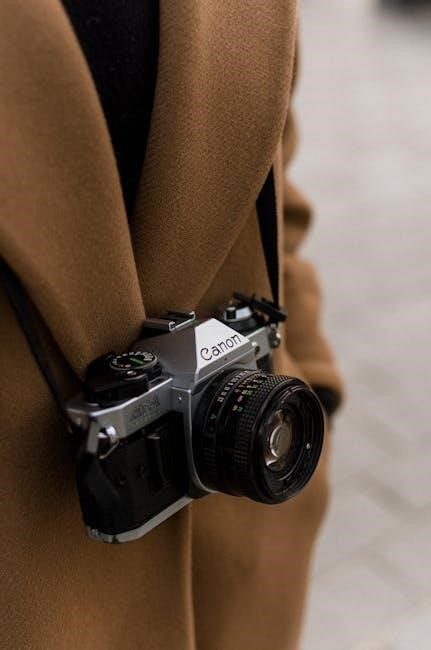
Image Quality and Settings
The Canon EOS 350D offers customizable image settings to optimize quality. Adjustments include resolution, compression, and color balance, ensuring photos meet individual preferences and professional standards effortlessly.
7.1 Understanding JPEG vs. RAW Formats
The Canon EOS 350D allows shooters to capture images in both JPEG and RAW formats, each with unique benefits. JPEG files are compressed, making them smaller in size and ideal for sharing, while RAW files retain all image data, offering greater flexibility in post-processing. Understanding these formats helps photographers choose the best option for their workflow and desired results. This section explains the differences, helping users make informed decisions based on their needs.
7.2 Adjusting Image Resolution
The Canon EOS 350D allows users to adjust image resolution to suit their needs. Resolution settings are accessed via the camera’s menu, offering options like Large, Medium, and Small sizes. These settings determine the pixel dimensions of the captured images. A higher resolution provides more detail, ideal for printing, while lower resolutions are better for sharing online. Users can also select aspect ratios to match their creative vision. Adjusting image resolution is crucial for balancing file size and quality, ensuring optimal results for various applications. This feature gives photographers flexibility in tailoring their images for specific purposes.

Using the Built-In Flash
The Canon EOS 350D’s built-in flash provides convenient lighting for low-light conditions, offering modes like Auto, Manual, and Red-Eye Reduction. It ensures balanced exposures and minimizes shadows effectively.
8.1 Flash Modes and Sync Options
The Canon EOS 350D’s built-in flash offers multiple modes, including Auto, Manual, and Red-Eye Reduction, ensuring versatile lighting control. The Auto mode automatically fires in low-light conditions, while Manual mode allows precise flash output adjustment. Red-Eye Reduction minimizes red-eye effects in portraits. Additionally, the camera supports 1st Curtain and 2nd Curtain sync for creative effects, such as freezing motion or capturing light trails. These modes and sync options can be easily accessed and adjusted through the camera’s menu system, providing users with enhanced flexibility for various lighting scenarios.
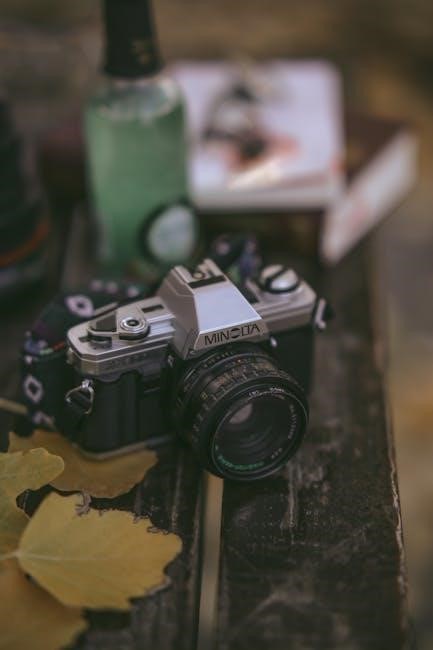
Working with External Accessories
The Canon EOS 350D supports various external accessories, such as flash units and remote shutters, enhancing functionality and creativity for diverse photography needs.
9.1 Using External Flash Units
The Canon EOS 350D supports external flash units, such as the Speedlite series, to enhance lighting control and creativity. Connect the flash via the hot shoe or PC terminal for reliable operation. Ensure compatibility with Canon’s E-TTL II system for precise flash exposure. Adjust settings like flash compensation through the camera menu for optimal results. External flashes expand versatility in low-light conditions and studio setups, offering more power and directional control than the built-in flash. Always test sync modes and power levels before shooting to achieve desired effects.
9.2 Connecting Remote Shutter Releases
To connect a remote shutter release to your Canon EOS 350D, use the N3-type remote terminal located on the camera’s side. Attach the RC-1 or RC-5 remote controller to this terminal for wireless operation. Ensure the camera is set to Remote Shooting mode via the menu. This allows you to trigger the shutter without physical contact, reducing camera shake. Test the connection by pressing the remote shutter button. Use this feature for tripod-based photography, self-portraits, or bulb shooting to achieve sharp images. Always ensure the remote is paired correctly and within range for reliable operation.
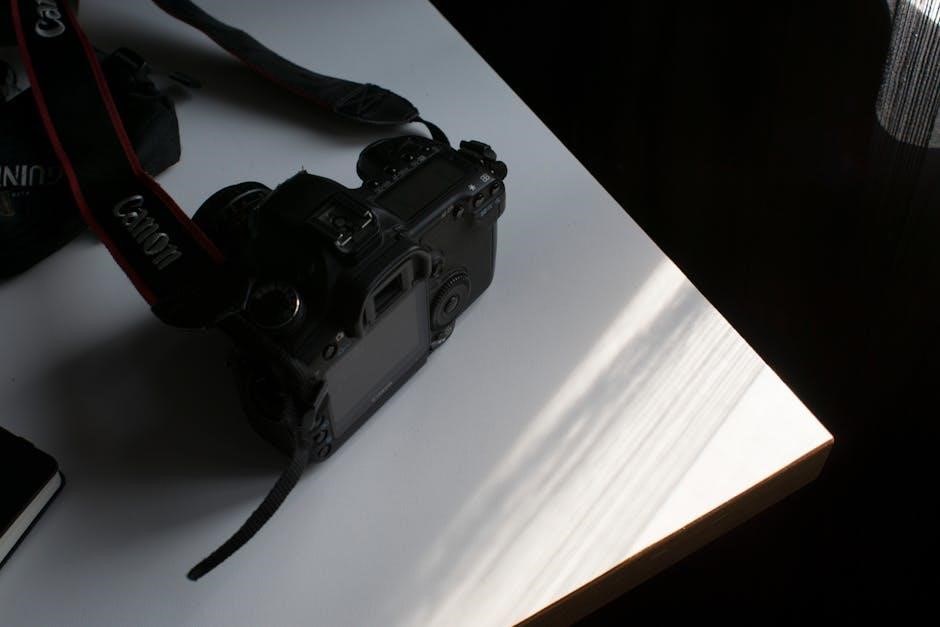
Camera Maintenance
Regularly clean the sensor and lens to prevent dust buildup, update firmware for optimal performance, and store the camera in a dry environment to ensure longevity and functionality.
10.1 Cleaning the Camera Sensor
Cleaning the Canon EOS 350D sensor is crucial for maintaining image quality. Turn off the camera, switch to “Clean Manually” mode, and remove the lens. Use a soft, dry brush to gently sweep away dust. For stubborn spots, apply a cleaning swab with a small amount of cleaning solution, lightly sweeping across the sensor. Avoid touching the sensor surface. If cleaning is ineffective, consider professional service. Regular maintenance ensures sharp, dust-free images and prolongs the camera’s performance. Always handle the sensor with care to prevent damage or contamination.
10.2 Updating Firmware
Updating the Canon EOS 350D firmware enhances performance, fixes issues, and adds new features. Visit the official Canon website, download the latest firmware version, and follow on-screen instructions. Use Canon’s EOS Utility software for a smooth update process. Ensure the camera battery is fully charged and avoid interrupting the update. After completion, restart the camera to apply changes. Regularly check for updates to maintain optimal functionality and compatibility with lenses or accessories. Firmware updates are essential for maximizing your camera’s potential and ensuring it operates at its best. Always use official Canon sources to download firmware for safety and reliability.
10.3 Storage and Travel Tips
Store your Canon EOS 350D in a protective case to prevent scratches and damage. Use silica gel packets to absorb moisture and avoid humidity. Clean the camera thoroughly before storage to prevent dust buildup. When traveling, pack the camera in a padded bag or hard case to protect against shocks. Ensure the battery is fully charged and consider bringing a backup. Avoid exposing the camera to extreme temperatures. Use a lens cleaning cloth regularly to maintain image quality. Always handle the camera with care to ensure longevity and optimal performance during your photography journeys.

Troubleshooting Common Issues
Common issues with the Canon EOS 350D include error messages, lens compatibility problems, and sensor cleaning. Regular updates and proper maintenance can resolve most issues effectively.
11.1 Common Error Messages
The Canon EOS 350D may display error messages such as “ERR 99,” indicating issues like lens communication problems or corrupted files. Other errors include “CARD FULL” or “NO IMAGE.” These messages often relate to memory card issues, lens incompatibility, or firmware glitches. Users can troubleshoot by cleaning the lens contacts, formatting the memory card, or updating the camera firmware. Referencing the manual or Canon support resources is recommended for resolving specific error codes effectively. Regular maintenance and software updates can help minimize these issues and ensure smooth camera operation. Always consult the troubleshooting guide for detailed solutions.
11.2 Accessing Technical Support
For assistance with the Canon EOS 350D, visit Canon’s official support website. Here, you can download the latest firmware, manuals, and software. The site also offers troubleshooting guides and repair service information. Additionally, Canon provides customer support through phone, email, or live chat. For independent help, online forums and communities, such as Canon user groups, often share solutions and tips. Always verify the credibility of sources to ensure accurate information. Regularly updating your camera’s firmware and software can resolve many common issues. Utilize these resources to maintain your camera’s performance and resolve technical difficulties effectively.
The Canon EOS 350D is a powerful tool for photography. Master its features and settings for exceptional results. Regularly update firmware and always handle the camera with care for optimal performance and longevity.
12.1 Best Practices for Camera Use
To maximize your experience with the Canon EOS 350D, always use genuine Canon lenses and accessories. Regularly clean the sensor and update firmware for optimal performance. Store the camera in a cool, dry place to prevent damage. When shooting, use a tripod for stability and ensure proper battery charging. Familiarize yourself with the manual to explore advanced features and settings. Practice consistent maintenance, such as cleaning the lens and checking for software updates, to ensure long-term functionality and image quality.
12.2 Continuous Learning and Improvement
Continuous learning is key to mastering the Canon EOS 350D. Experiment with different shooting modes and settings to understand their effects on your photos. Regularly review your images to identify areas for improvement. Stay updated with the latest photography techniques and Canon firmware updates for optimal performance. Engage with photography communities and forums to gain insights and tips from experienced users. Practice consistently to refine your skills, and explore Canon’s official resources for troubleshooting and advanced guidance. By dedicating time to learning and adapting, you can unlock the full potential of your camera and enhance your photography journey.
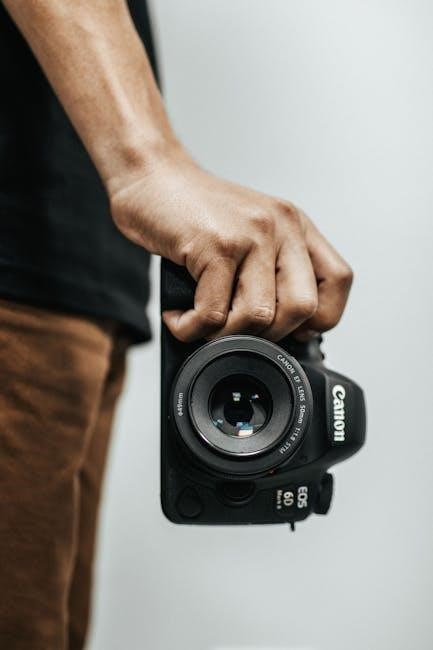



About the author